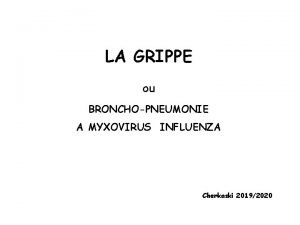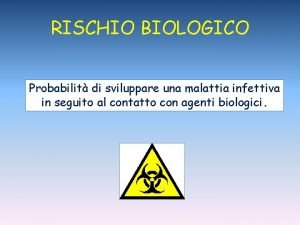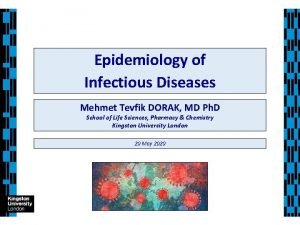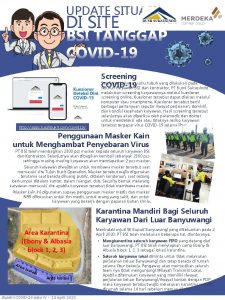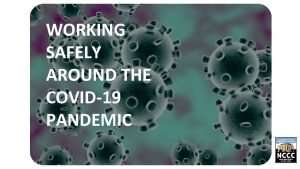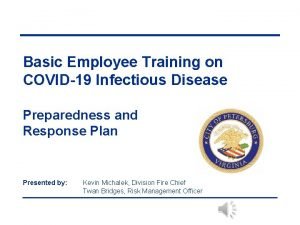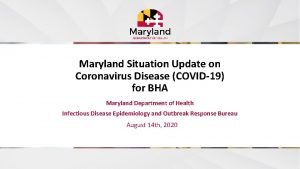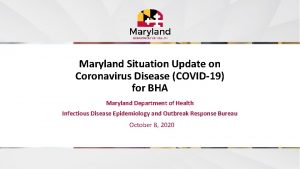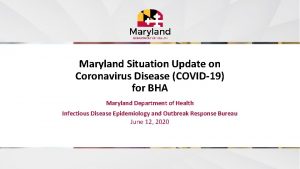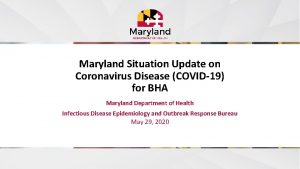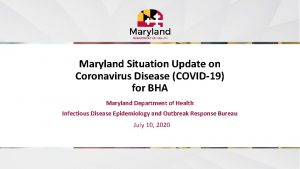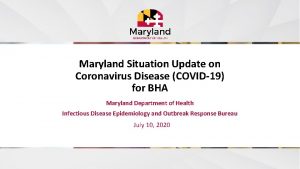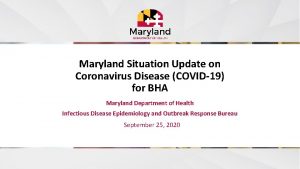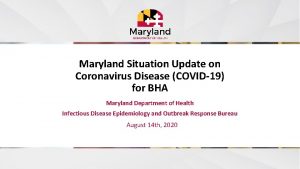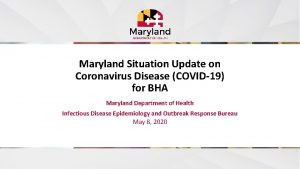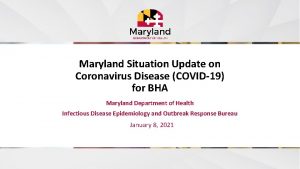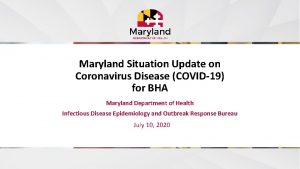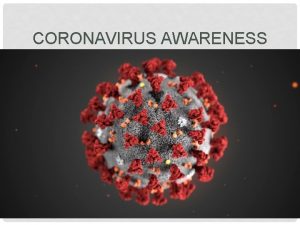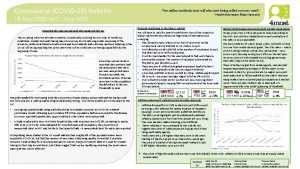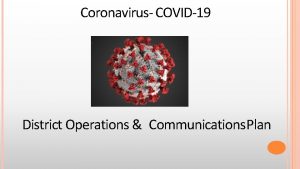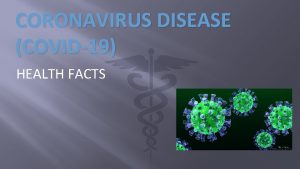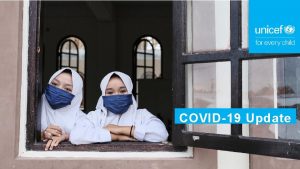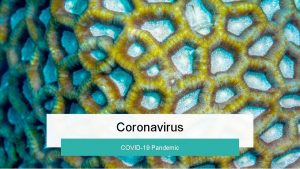Maryland Situation Update on Coronavirus Disease COVID19 for























- Slides: 23

Maryland Situation Update on Coronavirus Disease (COVID-19) for BHA Maryland Department of Health Infectious Disease Epidemiology and Outbreak Response Bureau February 12, 2021

Call Agenda Picture Courtesy of NIAID-RML • Review current situation of COVID-19 • Influenza Updates • CDC Updates • Q and A 2

COVID-19 Global Situation Summary 3 https: //gisanddata. maps. arcgis. com/apps/opsdashboard/index. html#/bda 7594740 fd 40299423467 b 48 e 9 ecf 6

US Case Counts and Rates https: //www. cdc. gov/coronavirus/2019 -ncov/casesupdates/cases-in-us. html Accessed 2/12/2021 4

Number of Cases Reported in the USA, by Day 5 https: //covid. cdc. gov/covid-data-tracker/#trends_dailytrendscases Updated 2/12/2021

COVID-19 Vaccinations in the United States 6

http: //health. maryland. gov/coronavirus Maryland: COVID-19 Cases • Cases: 368, 977 • 1, 112 new • Deaths: 7, 324 • 36 new • Hospitalizations: 32, 687 • Current: 1, 225 ( Down 80) • Total tests performed: 7, 388, 614 • Case rate: 19. 8 per 100, 000 7 Data current as of 2/12/2021

8 https: //coronavirus. maryland. gov/ 2/12/2021

9 https: //coronavirus. maryland. gov/ 2/12/2021

Testing Volume and % Positivity 10

11

Maryland Vaccine Dashboard 12 https: //coronavirus. maryland. gov/#Vaccine accessed February 12, 2021

Maryland Influenza Epi Update Week Ending January 30 th, 2021 Influenza-like illness (ILI) activity in Maryland was minimal 13

https: //phpa. health. maryland. gov/i nfluenza/Pages/flu-dashboard. aspx 14

https: //phpa. health. maryland. gov/in fluenza/Pages/flu-dashboard. aspx 15

CDC Updates

Considerations to Improve Ventilation Increase outdoor air ventilation increase fresh outdoor air by opening windows and doors Use fans to increase the effectiveness of open windows Increase airflow to occupied spaces when possible Open outdoor air dampers beyond minimum settings to reduce or eliminate HVAC air recirculation • Improve central air filtration • Consider portable high-efficiency particulate air (HEPA) fan/filtration systems to help enhance air cleaning • Consider using ultraviolet germicidal irradiation (UVGI) as a supplement to help inactivate SARS-Co. V-2 • • • 17 https: //www. cdc. gov/coronavirus/2019 -ncov/community/ventilation. html

Maximizing Fit for Cloth and Medical Procedure Masks to Improve Performance and Reduce SARSCo. V-2 Transmission and Exposure, 2021 • Emphasizes the importance of a close fitting medical mask • “modifications to improve fit might result in equivalent improvements, regardless of the masks’ baseline filtration efficiencies” • Knotting the sides of the medical mask can improve the fit • Still do not recommend the use of cloth masks in health care settings 18 https: //www. cdc. gov/mmwr/volumes/70/wr/mm 7007 e 1. htm? s_cid=mm 7007 e 1_w

Quarantine for vaccinated people • In NON-HEALTHCARE settings, vaccinated people with an exposure to a confirmed or suspect COVID-19 case do not need to quarantine if they: • Are fully vaccinated (i. e. , ≥ 2 weeks following receipt of the second dose in a 2 -dose series, or ≥ 2 weeks following receipt of one dose of a single-dose vaccine) • Are within 3 months following receipt of the last dose in the series • Have remained asymptomatic since the current COVID-19 exposure • As an exception to the above guidance no longer requiring quarantine for fully vaccinated persons, vaccinated inpatients and residents in healthcare settings should continue to quarantine following an exposure to someone with suspected or confirmed COVID-19 19 https: //www. cdc. gov/vaccines/covid-19/info-by-product/clinical-considerations. html#phrecs

Racial and Ethnic Disparities in the Prevalence of Stress and Worry, Mental Health Conditions, and Increased Substance Use Among Adults During the COVID-19 Pandemic — United States, April and May 2020 • What is already known about this topic? • Racial and ethnic minority groups have experienced disparities in mental health and substance misuse related to access to care, psychosocial stress, and social determinants of health. 20 https: //www. cdc. gov/mmwr/volumes/70/wr/mm 7005 a 3. htm? s_cid=mm 7005 a 3_w

Summary • Combined prevalence estimates of current depression, initiating or increasing substance use, and suicidal thoughts/ideation among U. S. adults aged ≥ 18 years were 28. 6%, 18. 2%, and 8. 4%, respectively. • Hispanic adults reported a higher prevalence of psychosocial stress related to not having enough food or stable housing than did adults in other racial and ethnic groups. • Addressing psychosocial stressors, mental health conditions, and substance misuse among U. S. adults during the COVID-19 pandemic is important, as are interventions tailored for racial and ethnic minority groups. 21

22

Questions? 23 Email : mdh. ipcovid@Maryland. gov
 Recovery techniques based on immediate update
Recovery techniques based on immediate update 2 factores abioticos
2 factores abioticos Scissurite coronavirus
Scissurite coronavirus Segnale di rischio biologico
Segnale di rischio biologico Relazione continuità scuola infanzia e primaria
Relazione continuità scuola infanzia e primaria Allegato xlvi del d.lgs. 81/08 coronavirus
Allegato xlvi del d.lgs. 81/08 coronavirus Mehmet tevfik dorak
Mehmet tevfik dorak Bronquite coronavirus
Bronquite coronavirus Http//apps.tujuhbukit.com/covid19
Http//apps.tujuhbukit.com/covid19 Vaksin covid19
Vaksin covid19 Do if you covid19
Do if you covid19 Covid19 athome rapid what know
Covid19 athome rapid what know What do if test positive covid19
What do if test positive covid19 Mdh situation update
Mdh situation update Communicable disease and non communicable disease
Communicable disease and non communicable disease Bris för vuxna
Bris för vuxna Mat för unga idrottare
Mat för unga idrottare Smärtskolan kunskap för livet
Smärtskolan kunskap för livet Trög för kemist
Trög för kemist Argument för teckenspråk som minoritetsspråk
Argument för teckenspråk som minoritetsspråk Etik och ledarskap etisk kod för chefer
Etik och ledarskap etisk kod för chefer Datorkunskap för nybörjare
Datorkunskap för nybörjare Humanitr
Humanitr Returpilarna
Returpilarna


